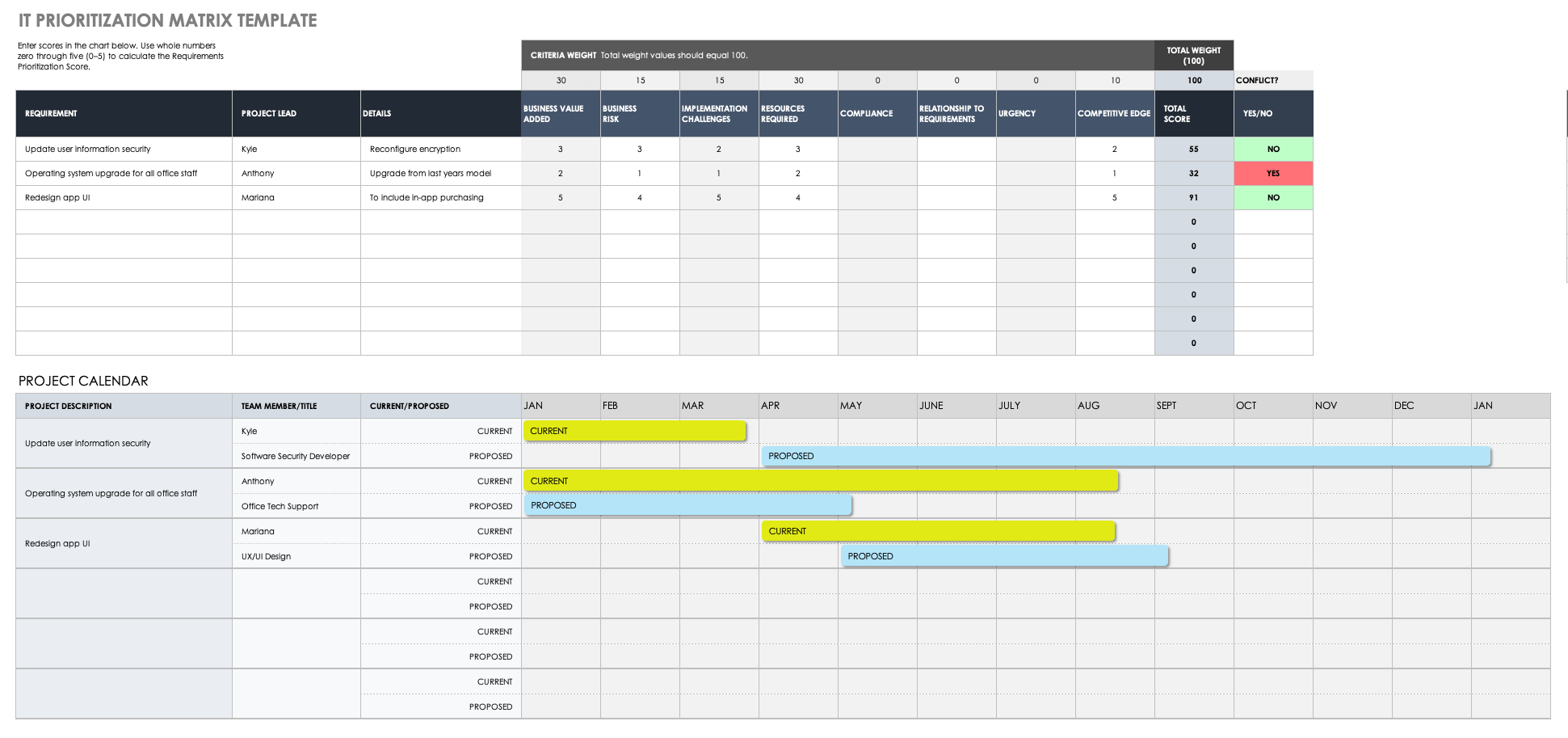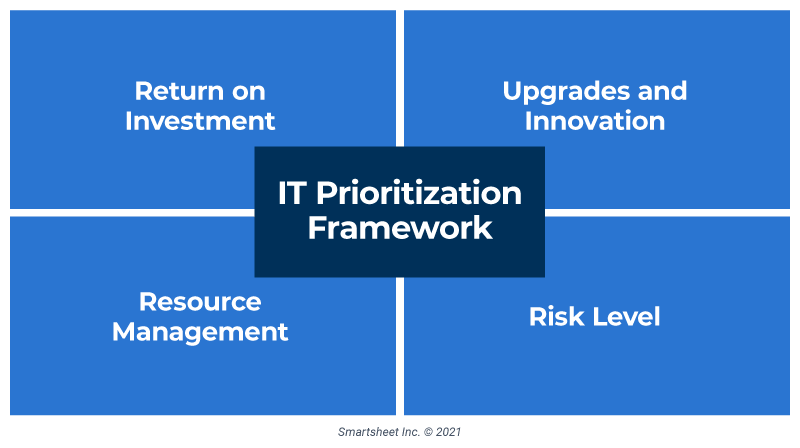What Is IT Project Prioritization?
IT project prioritization refers to the ranking and selection process of potential projects in an information technology (IT) environment. A team can use a priority matrix to facilitate this process, with criteria explicitly selected for the IT use case.
An IT project can be any project that specifically involves or interacts with IT department resources, including computer systems, enterprise systems, and communication systems.
Project and Portfolio Management E-book
Feel like work is moving faster than ever? It is.

In this introduction to project and portfolio management (PPM), learn how to streamline your efforts and get multiple projects — or an entire portfolio — over the finish line, on time and on budget.
IT Project Prioritization Criteria
When selecting IT project prioritization criteria, think about the potential value you can add to the business. With this in mind, the criteria may include competitive advantage, cost versus benefits, quality improvements, reduced potential risks, and opportunities for business growth.
The IT department deals mainly with the governance and functionality of technology, hardware maintenance, and programming. IT projects almost always involve computers and technology, but the specifics of the IT department will vary between organizations.
How to Prioritize IT Projects
You should prioritize IT projects based on their value contribution to the business. Evaluate revenue potential, resources used, and possible risks for each project. Companies should choose their next project based on the total benefit that it creates or provides.
You can prioritize IT projects using many of the same tools and techniques you employ in other departments, but the selection criteria may vary. IT departments are usually highly specialized, so the team resources and workforce may be limited in a way that other departments are not. Your organization may even employ an information technology project management office (IT PMO) to oversee project management and prioritization for any IT projects.
Miranda Yan, Founder of VinPit, suggests “cutting out ‘good enough’ goals” and “prioritizing the most critical work during the most productive hours.” For daily planning, she says, “rank daily tasks by proper priority. Separate tasks with similar priorities using the ABCDE method. Set a productive tone for the day by doing the most important work first.”
How to Measure Business Value
Business value refers to the capital and benefits that a business creates for its stakeholders. The best way to measure business value is to compare a business’s increase in revenue to its assets year over year.
In an IT scenario, business value is measured specifically by the value added to a business from the IT department. A company should compare the value of IT projects over time to ensure that they are still profitable and aren’t wasting resources that could be better utilized on other ventures. IT employees are typically highly skilled, and their niche skills can contribute markedly to business value. It is important to consider the time resources of your skilled employees in this calculation as well.
IT Project Prioritization Process
The IT project prioritization process involves comparing criteria that the team has chosen specifically to rank the importance of two or more potential projects. Give special consideration to the existing projects and time commitments of your IT team.
- List Your Potential Projects: Create a list of your next potential projects or tasks. Consult with stakeholders to ensure that your list is as comprehensive as possible.
Potential IT projects might include updating the security of your users’ information, a redesign of your app’s user interface, or a large update to the operating system that your office staff uses. - Choose and Weight Your Prioritization Criteria: IT prioritization criteria should consider both the value the project will add to the business and the resources that completing it requires.
You might consider evaluating projects based on the resource requirements for existing projects, the potential for increased revenue, and any risks or implementation challenges that may arise. - Apply Your Criteria: Many teams use a prioritization matrix to apply their chosen criteria. Matrices allow for an unbiased overview of your list of tasks ranked by your chosen criteria.
Assign a numerical value to each criterion for each project on your list. The summation of those values then becomes a score for each item that you can use for comparison. - Analyze Results: Look over the results of your matrix and evaluate them. Typically, a higher score means a more significant project, but ensure that your results make sense. If they do not, re-evaluate your criteria and try again.
- Start Your Next Project: Schedule and complete your next tasks based on the results of this prioritization process.
How to Create a Criteria-Based Matrix for IT
To create a criteria-based matrix for IT projects, first create a list of tasks. Then, determine your prioritization criteria and their weights. Score each item on the list, and compare the total scores to determine your next project.
The steps involved in creating a criteria-based matrix for IT are similar to creating a general project selection matrix; the main difference is in selecting and weighting those criteria.
“We often draw up priority matrices during the planning phase of products,” says Sander Tamm, CEO of the e-learning platform E-Student. “It doesn’t take much time to plot, and the visual helps make it clear which tasks need urgent attention and which can be pushed off for now.”
- Create a List of Potential Projects or Tasks: Speak with key decision-makers to organize your next potential projects in one place. “We determine which factors to measure by first building a master list of tasks required to complete each project,” says Tamm.
- Determine Criteria and Their Weights: Consider both the potential value added to the business and the existing commitments of your team.
- Input Scores for Each Item on the List: Numerically score each criterion for each item on the list.
- Analyze Results: Generally the highest scores are the most desirable projects, but be sure to compare the results to other existing projects within the same portfolio.
“A priority matrix is just a better way to measure how critical each individual task is so that you can build a smart project timeline accordingly,” says Tamm.
IT Project Prioritization Matrix Template
Download IT Project Prioritization Matrix Template
Microsoft Excel | Google Sheets
We’ve created this template with IT projects in mind. Easily customize the prioritization criteria and their weights to fit your needs, and use the project timeline to keep an eye on your team’s projects in progress.
To download more priority matrices and templates, visit “Free Priority Matrix and Project Prioritization Templates.”
How to Prioritize IT Projects Portfolio
The first step to prioritize an IT project portfolio is to identify the ultimate goal of the portfolio as a whole. Then, use a priority matrix to compare projects with an eye for their contribution toward that goal.
Regularly check in on your portfolio, and ensure that company time and resources are still being allocated appropriately. Both needs and resources can change over time, and it is important to reassess your priorities regularly. Make sure you are spending the most time on the projects that are the most valuable to the team and company as a whole.
Some goals will overlap and some may conflict. It is important to consider the implications of new projects and their effects on existing ones to ensure that you are appropriately managing resources.
What Are the Important Factors in Prioritizing IT Projects?
Prioritizing IT projects takes some special considerations. We’ve asked experts to provide insight on the most important factors, including using appropriate models, encouraging executive buy-in, and consideration of the existing projects of your team.
- Help Facilitate Executive Decision-Making: Yan describes how project prioritization has helped her facilitate the selection process in her organization: “To break down and prioritize complex issues when multiple factors are influencing the decision, objectively and unambiguously rank your priorities. Determine the most crucial focus areas, build a basis for discussion about what is essential, and garner team stakeholder support for important buy-ins.”
- Identify the Most Important Comparison Criteria: The criteria that you choose to compare will determine the priority rank of the projects, so it is critical to identify those criteria. Common prioritization criteria include risk level, ROI, and resource use.
- Use Appropriate Scoring Models and Templates: Use the priority matrix that best fits your needs. Simpler models may be more useful for prioritizing daily task lists, while more complex models can weigh more criteria over numerous projects.
- Consider the Existing Commitments of Your Team: Your team members’ time has value. Ensure that they are not overburdened by any additional tasks or projects. “If you don’t properly assess the impact or effort of your tasks, you might end up losing some team productivity and running into issues,” warns Tamm.
To learn more about the specific needs of managing IT projects, read “An Indispensable Guide to On-Time, On-Budget IT Project Management.”
IT Project Prioritization Framework
The IT project prioritization framework is an organizational structure that supports the prioritization and selection process. It lays out how to measure costs and benefits and compare projects to one another, as well as the essential criteria for selection.
These frameworks exist to serve as a guide for an organization to standardize its prioritization processes in the future. Each company and team will decide on the framework that works best for them, but typically your goal should be to balance available resources and potential value added to the company. For more information about specific frameworks and their applications, check out “How to Use Strategic Planning Frameworks and Models.”
An IT prioritization framework provides a simple method of staying consistent in your prioritization process. Consistency helps encourage executive and stakeholder buy-in, as well as keep the process neutral and continue to work toward the best outcome for the company.
Streamline the IT Project Prioritization Process with Real-Time Work Management in Smartsheet
Empower your people to go above and beyond with a flexible platform designed to match the needs of your team — and adapt as those needs change. The Smartsheet platform makes it easy to plan, capture, manage, and report on work from anywhere, helping your team be more effective and get more done. Report on key metrics and get real-time visibility into work as it happens with roll-up reports, dashboards, and automated workflows built to keep your team connected and informed. When teams have clarity into the work getting done, there’s no telling how much more they can accomplish in the same amount of time. Try Smartsheet for free, today.


